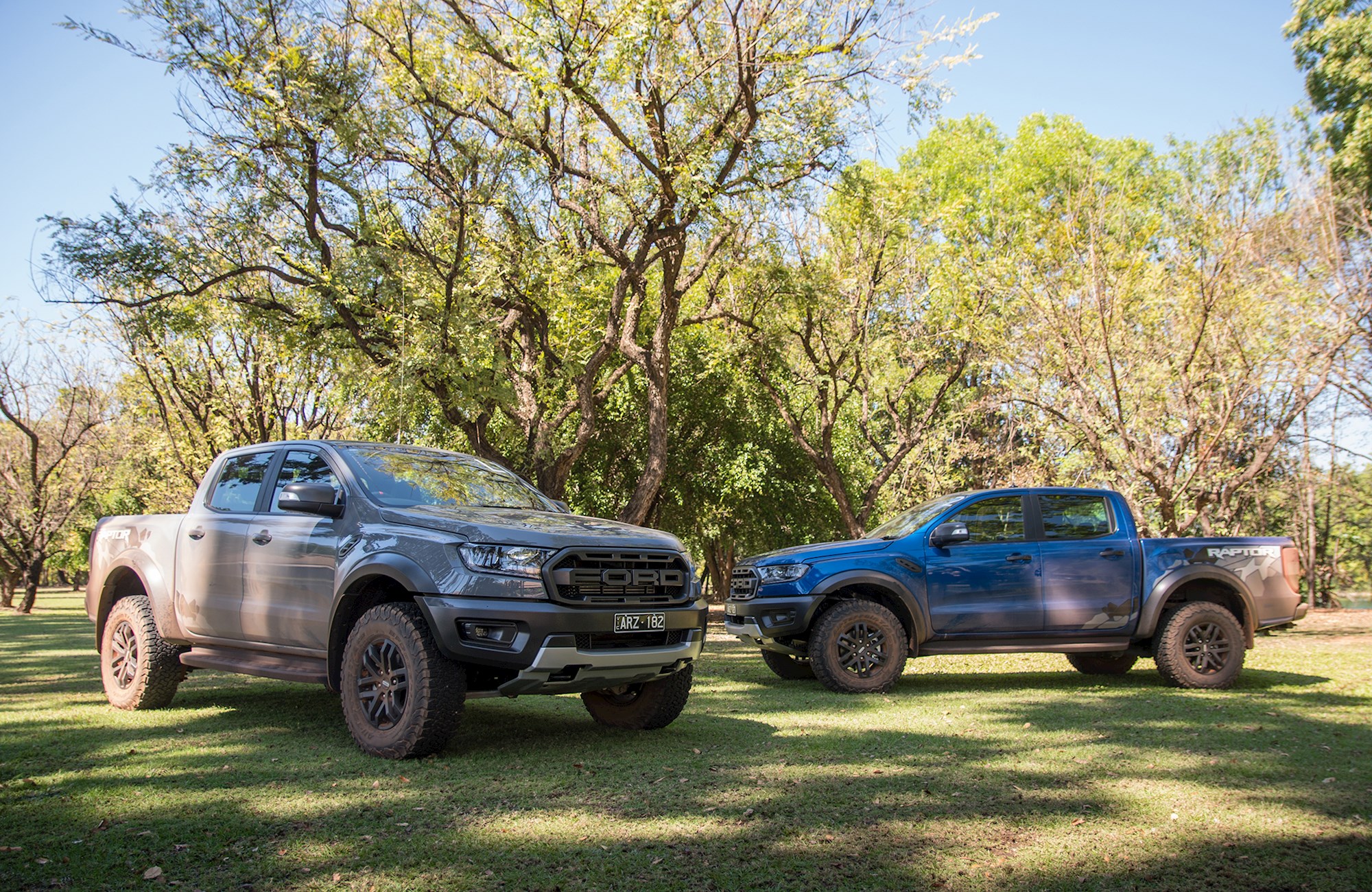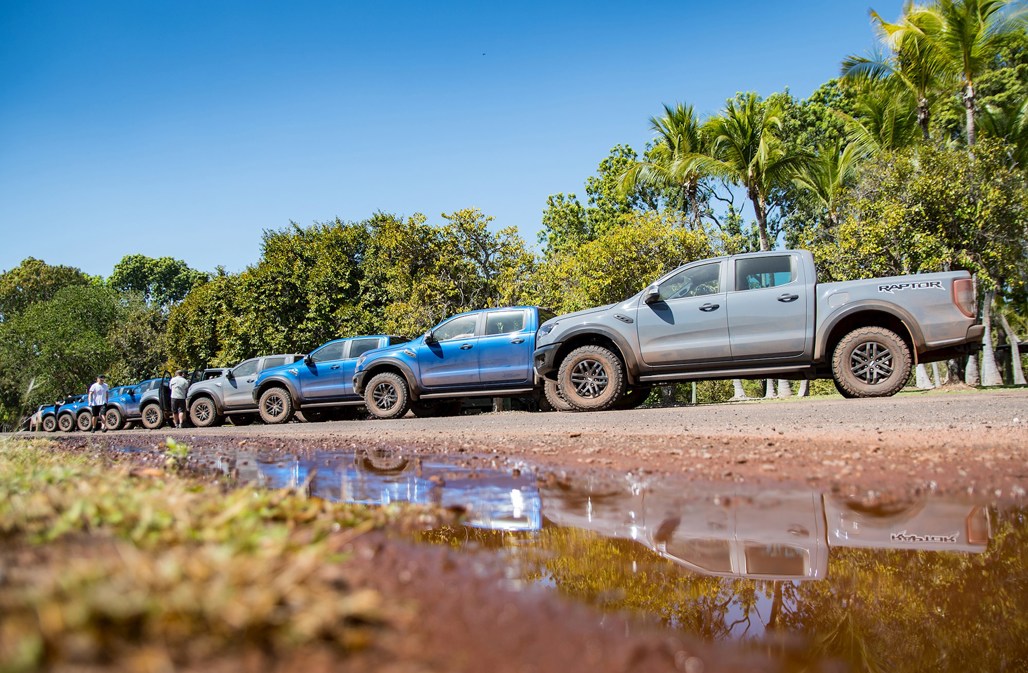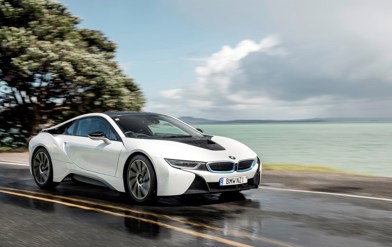He’s dressed in khaki, topped with an Akubra. “All our water is full of crocodiles,” he says. “And in fact the creek you’ll drive across... we just pulled a 4.31m crocodile out of it.
“Don’t get out and have a swim there, either.”
Clinging to every word is a legion of dress-shirt journos. Some muster a nervous chuckle, while the eyes of others dart from the man in the Akubra to the nearby body of water.

The new Ford Ranger Raptor aims to meet that “townie versus country” divide somewhere in the middle.
That appeal, combined with the boom in ute sales, has seen it become one of the most heavily hyped vehicles to hit Australasia in years.
And naturally, Ford pulled out all the stops for its global launch.
Tipperary Station is an hour or so south of Darwin. It's a 210,000ha block that operates as a cattle station and is largely self-contained, with its own school and general store.
The station was also the perfect backdrop playground for the Raptor; its snaking gravel roads and rock-crawling courses carved into signature Northern Territory red dust.

In the absence of road tests and drives, couch-based pundits have thrown plenty of criticism at the littlest Raptor's numbers game. And, from some angles, they have a point.
Without question the most controversial thing about it is its engine.
It's a new 2-litre bi-turbodiesel that channels 157kW of power and 500Nm of torque to the Ranger's wheels, and flat tack it will hit 100km/h in 10.4 seconds.

For those wanting our first Raptor experience to echo that of the muscular distant F-150 relative, those figures could be a disappointment. Consider, too, that fuel economy doesn’t grow by much either. The 3.2-litre Wildtrack comes with claimed figures of 8.7L/100km, while the Raptor merely shades it at 8.2L/100km (we dipped as low as 10L/100km).
With the engine lacking mid-range punch in a straight line, too — particularly noticeable in the motorway passing lane Grand Prix — does it all mean that the Ranger Raptor is a dead duck already, before it's even hit the showrooms?
No. Not even close.

Tipperary Station features several specific off-roading courses. These include a flowing eight-minute circuit and a slow-paced rock crawl that we took on ourselves, plus a more challenging lap punctuated by jumps and complex set pieces that we experienced alongside a professional driver.
This provided the perfect platform for the Ranger Raptor's comprehensive web of other changes.
Under the skin, it is one of the most comprehensive off-road vehicles on the market, and a very different beast when compared to a standard Ranger.

The chassis has been strengthened and given extra protection, the track has widened and ride-height is increased (approach, ramp-over, and departure angles are 32.5, 24, and 24 degrees respectively, while ground clearance is 283mm). There's a smorgasbord of new drive modes, and disc brakes and beefy 285mm BF Goodrich all-terrain tyres come on all four corners.
But without question, the Ranger Raptor's most significant ace is its suspension set-up.

A Watt's linkage and coil-overs in the rear combine with Fox Racing 2.5 shock absorbers to replace the standard Ranger's leaf springs. Each of the shocks features a 46.6mm piston with an internal bypass, which gives the ability to separate its travel into specific zones.
Full compression and extension (which Ford refers to as the bump zone and catch zone) triggers a bump stop effect, channelling fluid to the top of the piston to iron out landings and prevent bottoming out.
To put it in Ford Vehicle Dynamics lead engineer Simon Johnson's own layman's terms, at full compression and full extension the shocks are like “a soft-closing cutlery drawer”.

If you're asking yourself where the premium for the Raptor's $84,990 RRP is being spent, these shocks are the answer. Combined, they're worth the same as the four-cylinder engine under the bonnet and in off-road use they are utter bliss.
Both drive courses featured deep dips in the road, the sort of dips that would fold most double-cab utes in half given a chance. But the Raptor would take them with glee at 80km/h and up, with nothing more than a subtle bit of movement in the cabin to show for it.
Naturally it loves to jump, too — landings are soft and spectacularly unspectacular.

There is, however, a trade-off — the softer rear end means a reduction in towing capacity and payload, which decreases from 3.5 tonne and 900kg in the Wildtrak to 2.5 tonne and 700kg in the Raptor.
On dirt is where the Ranger Raptor really comes together. The superbly weighted rebound rates of the shocks minimise reactive behaviour while boosting driver confidence. That combines with Ford's “Baja” drive mode, the playful, rev-happy 2-litre, and its 10-speed automatic transmission to form an insanely capable off-road paddock-basher that can hold slides with ease.
And the benefits go beyond the fast-paced jumping, drifting hooliganism.

On the slow, technical rock crawl, the Raptor showcased plenty of skill. At its steepest incline, the course would've almost nudged 50 degrees of angle, and we were able to bring the Raptor to a complete stop mid-climb before heading off again — all without touching its low-range four-wheel drive mode.
And when you swap dirt for tarmac, you'll find the suspension changes make it more comfortable and quiet than a standard Ranger, and surprisingly engaging to throw around corners.

There are other modifications too, like Ford's decision to shift the Diesel Particulate Filter in response to claims it would start fires when parked on long grass. A valid safety measure, although it raises the question as to why the Ranger Raptor misses out on the autonomous emergency braking and adaptive cruise control that is standard in the Wildtrak.
The irony of the Raptor is that its wealth of truly incredible off-road talents are unlikely to be exploited by most of its buyers; of which there are plenty, given about half of Ford New Zealand's 2018 allotment are already pre-sold.

For them, the Raptor's imposing Ranger on roids looks and improved road holding are instead going to be the leading motivators. And there's nothing wrong with that.
I can only hope that they can appreciate just how advanced and how incredibly capable their ute truly is.





























